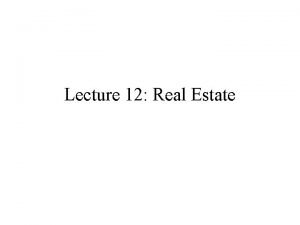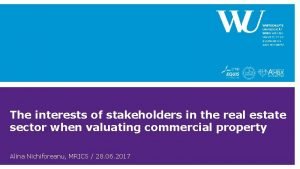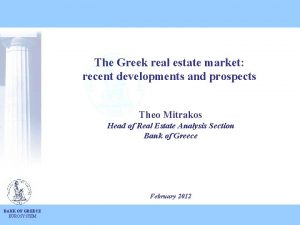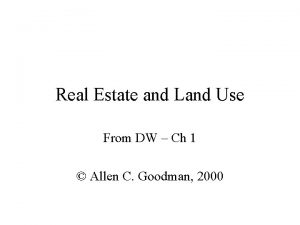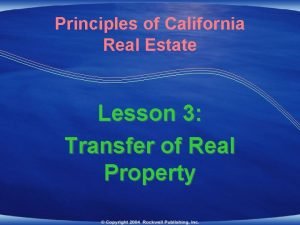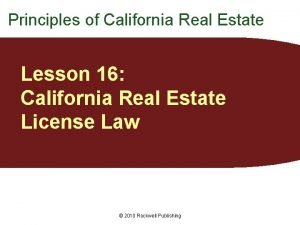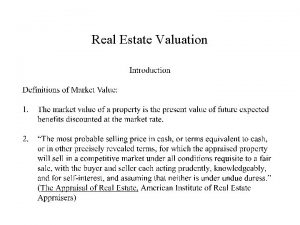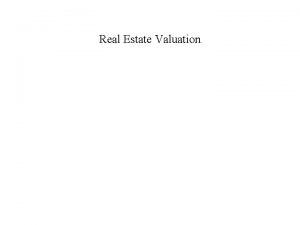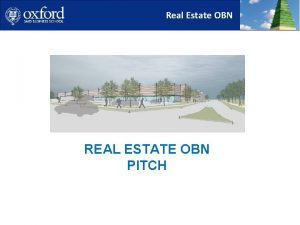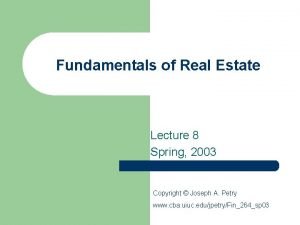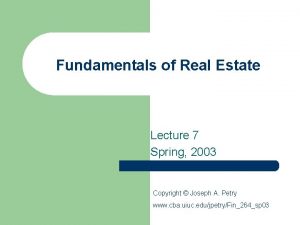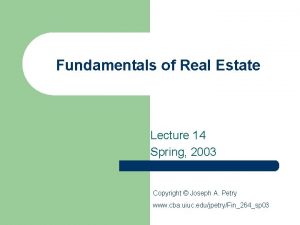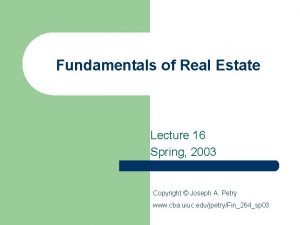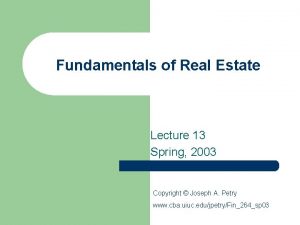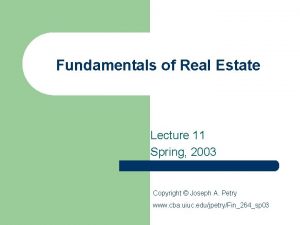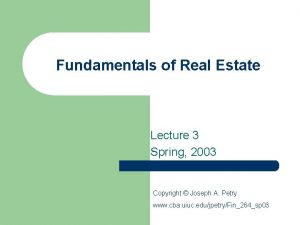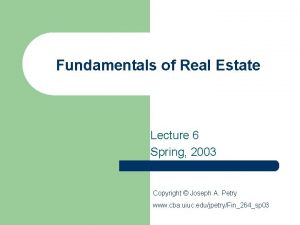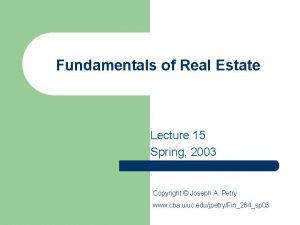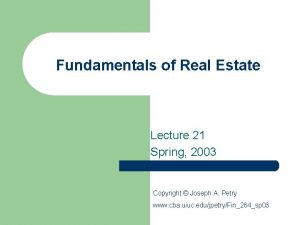Fundamentals of Real Estate Lecture 2 Spring 2003

















- Slides: 17

Fundamentals of Real Estate Lecture 2 Spring, 2003 Copyright © Joseph A. Petry www. cba. uiuc. edu/jpetry/Fin_264_sp 03

Investment Analysis l l 2 A great deal of our time will be spent developing different ways of evaluating the profitability of various real estate investment alternatives. We begin that process in Chapter 2, utilizing the time-value-of-money tools that we have just reviewed (Net Present Value or NPV), and related yield measures (Internal Rate of Return or IRR).

Investment Analysis-NPV 3

Investment Analysis-NPV l l NPV = PVin – PVout Assume: – l discount rate of 10%, purchase prices of $450, 000 (Cedar Ridge) and $420, 000 (Oak Glen) NPV for Cedar Ridge: $-15, 523. 03 – PVin = $434, 476. 97. PV of cash flows and estimated sales proceeds in five years – Pvout = $450, 000. 00 Purchase Price 4 – NPV = -15, 523. 03

Investment Analysis-NPV 5 l NPV for Oak Glen: ? l Which investment is better? l Which investment(s) is(are) acceptable? l What does our decision tell us about the return associated with our investment relative to our discount rate?

Investment Analysis-Yield Measures l l l 6 IRR is one of the most frequently used yield measures employed. As you recall, IRR is the discount rate which equalizes inflows and outflows. In other words, if you used the IRR as your discount rate in the NPV examples above, you would have ended up with an NPV = 0. Unlike NPV, IRR is directly comparable across investments.

Investment Analysis-Yield Measures l To solve the Cedar Ridge example for IRR: N = 5, PV = -450, 000, PMT = 45, 000, FV = 425, 000, I = ? I CPT = 9. 0731% l 7 Find the IRR for Oak Glen:

Investment Analysis-Yield Measures l Decision Rules for NPV: – – – l Decision Rules for IRR: – – 8 If NPV is positive, then invest If NPV is positive on a number of investments, pick the investment with the highest NPV If NPV is 0, you are indifferent and can go either way. If NPV is negative, keep looking! If IRR is greater than your required return/hurdle rate than invest. If IRR is equal to required return you are indifferent, and if less don’t invest.

Investment Analysis-Yield Measures l Lender Yield/Effective Cost of Borrowing: – – 9 IRR is also used to calculate the Lender Yield/Effective Cost of Borrowing. The Lender Yield is the lenders effective return after considering points paid as a part of the loan. The ONLY difference between Lender Yield and Effective Cost of Borrowing is the perspective (lender vs. borrower). If the loan does not involve points, the Lender Yield & Effective Cost of Borrowing are identical to the stated interest rate of the loan (contract rate of interest). When points are paid as part of obtaining a loan, the borrower is paying 1% of the face value of the loan for each point. This is paid up-front, usually by subtracting from loan amount. In return for paying point(s), the borrower receives a lower interest rate.

Investment Analysis-Yield Measures l Lender Yield/Effective Cost of Borrowing: – Assume two alternative lending/borrowing options: l l A $100, 000 loan with terms of 11%, 30 years, annual. A $100, 000 loan with terms of 10%, 30 years, annual, with 4 points up front borrowing cost. ($100, 000 loan; $4, 000 in points; net loan = $96, 000) – – Which is best for borrower? For lender? 1) Determine cash flows with each loan: A) annual payment = – B) annual payment = net loan amount= – – 2) Determine IRR for each loan: A) IRR = ? – B) IRR = ? – 10 Contract rate = ? Lender Yield = ?

Investment Analysis-Yield Measures l Capitalization (Cap) Rate: – – 11 The Cap rate is another frequently used yield measurement. It is defined as NOI/Acquisition Price. For example, for Oak Glen 40, 000/450, 000=8. 888% For Cedar Ridge: Also referred to as the “overall rate of return”. It is a measure between a property’s current income and its price (similar to dividend yield on a stock). All else equal, higher cap rates are better—but this measure is very limited as it only measure one year’s cash flow.

Investment Analysis-Yield Measures l Loan Amortization: – Most real estate loans are amortized (principal is repaid) over time. – – – 12 Balloon mortgages or interest only mortgages do not amortize The borrower typically pays a fixed payment, with a portion of the payment going to repay principal, and the rest to pay interest. In the early stages of a loan, the vast majority of the payment is interest. As the principal balance is slowly paid down, the amount of the loan payment going to interest declines, allowing more of the payment to be credited to principal reduction.

Investment Analysis-Yield Measures 13

Investment Analysis-Yield Measures l Remaining Mortgage Balance (RMB): – – 14 In addition to being able to calculate the loan payment for a fixed rate loan, you also will need to know the share of interest and principal of each payment. We will use the time value of money concepts to calculate the RMB. At the initiation of a loan, the net loan amount is equal to present value of the payments, discounted at the loan’s IRR. Assuming no points up front, the loan’s IRR is also the contract interest rate. Discounting the remaining payments at the IRR of the loan at any point in the loan, will give you the RMB.

Investment Analysis-Yield Measures l Remaining Mortgage Balance: – – – 15 – Assume a 30 year loan on a 175, 000 piece of property, a loan-to-value ratio of 80%, 7% interest, compounded monthly, with no points up front. What is the monthly payment on this loan? What is the present value of these payments over the next 360 months discounted at 7%? After 5 years, what is the present value of the remaining monthly payments? What must be the principal portion of the next payment? What must be the interest portion of that payment?

Investment Analysis-Yield Measures l 16 Test Yourself: – 3) How much would you pay to receive $50 in one year and $60 in the second year if you can earn 15% interest? – 4) What amount invested each year at 10% annually will grow to $10, 000 at the end of five years? – 6) What is the present value of $500 received at the end of each of the next three years and $1, 000 at the end of the fourth year, assuming a required rate of return of 15%?

Investment Analysis-Yield Measures l Test Yourself: – – – 17 9) In an income-producing property is priced at $5, 000 and has the following income stream would an investor with a required rate of return of 15% be wise to invest at the current price? Year 1 1, 000 Year 2 -2, 000 Year 3 3, 000 Year 4 3, 000
 Giduk
Giduk Fundamentals of analyzing real estate investments
Fundamentals of analyzing real estate investments Real estate finance fundamentals
Real estate finance fundamentals Real estate lecture
Real estate lecture South pointe village apartments fishers in
South pointe village apartments fishers in 01:640:244 lecture notes - lecture 15: plat, idah, farad
01:640:244 lecture notes - lecture 15: plat, idah, farad Spring fall summer winter
Spring fall summer winter Realtor elevator pitch
Realtor elevator pitch What is a mofir
What is a mofir Real estate stakeholders
Real estate stakeholders Greek real estate market
Greek real estate market Sandy miller real estate
Sandy miller real estate Littoral water rights
Littoral water rights What are the 4 types of real estate
What are the 4 types of real estate Crm software for real estate law
Crm software for real estate law Four quadrant model
Four quadrant model Involuntary alienation
Involuntary alienation Blind ad real estate
Blind ad real estate



